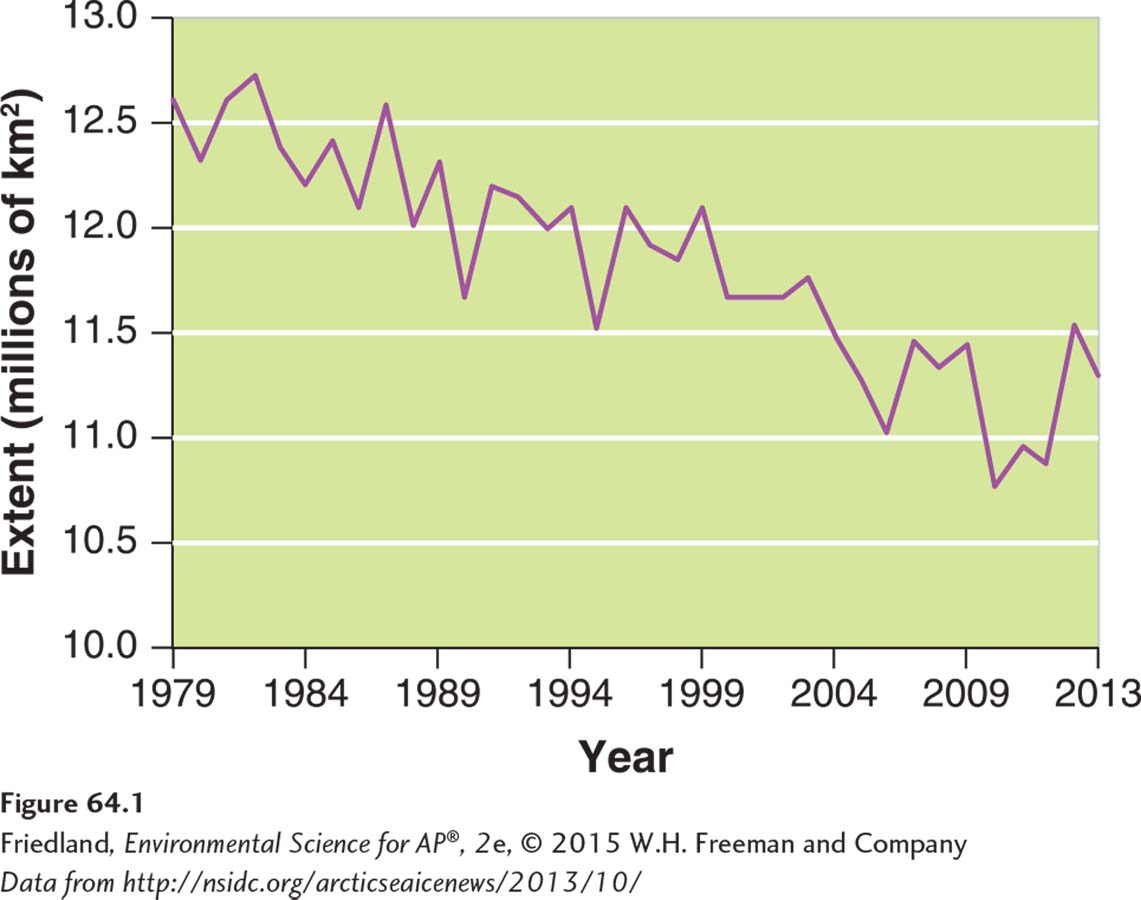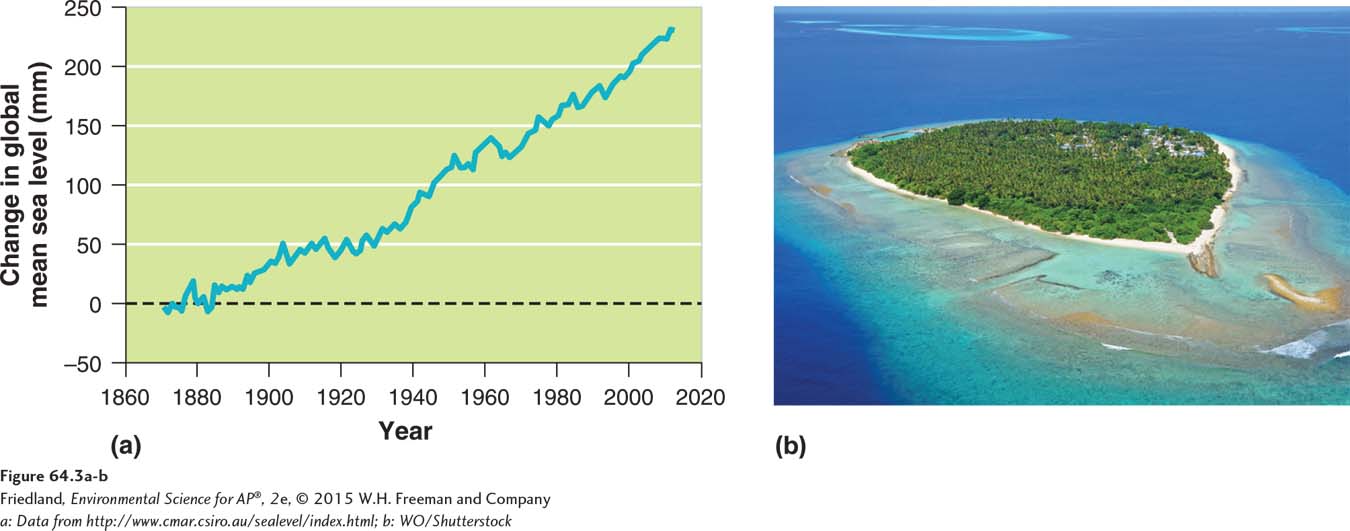module 64 Consequences of Global Climate Change
A wide range of environmental indicators demonstrate that global warming is affecting global processes and contributing to overall global change. In many cases, we have clear evidence of how global warming is having an effect. In other cases, we can use climate models to make predictions about future changes. As with all predictions of the future, there is a fair degree of uncertainty regarding the future effects of global warming. In this module, we will discuss how global warming is expected to affect the environment and organisms living on Earth.
Learning Objectives
After reading this module you should be able to
discuss how global climate change has affected the environment.
explain how global climate change has affected organisms.
identify the future changes predicted to occur with global climate change.
explain the global climate change goals of the Kyoto Protocol.
Global change includes global climate change and global warming
Warming temperatures are expected to have a wide range of impacts on the environment. Many of these effects are already happening, including melting of polar ice caps, glaciers, and permafrost and rising sea levels. Other effects are predicted to occur in the future, including an increased frequency of heat waves, fewer and less-

Polar Ice
As we have seen, the Arctic has already warmed by 1°C to 4°C (1.8°F–
Over the next 70 years, the Arctic is predicted to warm by an additional 4°C to 7°C (7°F–
In addition to the polar ice cap in the Arctic, Greenland and Antarctica have also experienced melting. As you can see in FIGURE 64.2, sea ice mass has been measured in Antarctica and Greenland from 2000 to 2013. During this time, Antarctica has lost more than 1,300 gigatons (about 3,000 trillion pounds) of ice while Greenland lost more than 3,000 gigatons (6,600 trillion pounds) of ice. The polar ice cap in Antarctica is particularly interesting. It has shown a small increase in total area over the past three decades. However, the mass of the ice cap includes both area and thickness. Because the ice cap is losing thickness due to melting, its overall mass has been reduced. Current evidence shows that the melting rate of these ice-

Glaciers
As we discussed in Chapter 9, global warming has caused the melting of many glaciers around the world. Glacier National Park in northwest Montana, for example, had 150 individual glaciers in 1850 but has only 25 glaciers today. It is estimated that by 2030 Glacier National Park will no longer have any glaciers. The loss of glaciers is not simply a loss of an aesthetic natural wonder. In many parts of the world the melting of glaciers starting each spring provides a critical source of water for many communities. Historically, these glaciers partially melted during the spring and summer and then grew back to their full size during the winter. However, as summers become warmer, glaciers are melting faster than they can grow back in the winter, which leaves some people without a reliable water supply.
Permafrost
As warmer temperatures cause ice caps and glaciers to melt, it is perhaps not surprising that areas of permafrost are also melting. You may recall from the discussion on biomes in Chapter 4 that permafrost is permanently frozen ground that exists in the cold regions of high altitudes and high latitudes, which include the tundra and boreal forest biomes. About 20 percent of land on Earth contains permafrost; in some places it can be as much as 1,600 m (1 mile) thick. Melting of the permafrost causes overlying lakes to become smaller as the lake water drains deeper down into the ground. Melting can also cause substantial problems with human-
Melting permafrost also means that the massive amounts of organic matter contained in the tundra will begin to decompose. Because this decomposition would be occurring in wet soils under low-
Sea Levels
The rise in global temperatures affects sea levels in two ways. First, the water from melting glaciers and ice sheets on land adds to the total volume of ocean water. Second, as the water of the oceans becomes warmer, it expands. FIGURE 64.3 shows that, as a result of both these effects, sea levels have risen 220 mm (9 inches) since 1870. Scientists predict that by the end of the twenty-

Global climate is already affecting organisms
The warming of the planet not only is affecting polar ice caps and sea levels but also is affecting living organisms. These effects range from temperature-
During the last decade, the IPCC reviewed approximately 2,500 scientific papers that reported the effects of warmer temperatures on plants and animals. The panel concluded that over the preceding 40 years, the growing season for plants had lengthened by 4 to 16 days in the Northern Hemisphere, with the greatest increases occurring in higher latitudes. Indeed, scientists are finding that in the Northern Hemisphere many species of plants now flower earlier, birds arrive at their breeding grounds earlier, and insects emerge earlier. At the same time, the ranges occupied by different species of plants, birds, insects, and fish have shifted toward both poles.

Rapid temperature changes have the potential to cause harm if organisms do not have the option of moving to more hospitable climates and do not have sufficient time to evolve adaptations. Historically, organisms have migrated in response to climatic changes. This ability to migrate is one reason that temperature shifts have not been catastrophic over the past few million years. Today, however, fragmentation of certain habitats by roads, farms, and cities has made movement much more difficult. In fact, this fragmentation may be the primary factor that allows a warming climate to cause the extinction of species.
The pied flycatcher (Ficedula hypoleuca) is a bird that provides an interesting example. In the Netherlands, the pied flycatcher has evolved to synchronize the time that its chicks hatch with the time of peak abundance of caterpillars, a major source of food for the newly hatched birds (FIGURE 64.4). In 1980, the date of hatching preceded the peak in caterpillar abundance by a few days, so there was plenty of food for the new chicks. Twenty years later, warmer spring temperatures have caused trees to produce leaves earlier in the spring. Because the caterpillars feed on tree leaves, the peak abundance of caterpillars now occurs about 2 weeks earlier than it did in 1980. However, the hatching date of the pied flycatcher has not been affected by temperature change. Thus, by the time the chicks hatch, the caterpillars are no longer abundant and the hatchlings lack a major source of food, causing flycatcher populations in these areas to decline by 90 percent. There are other similar examples of the effects of rapid temperature change throughout the natural world.
Corals are one group of organisms that are particularly sensitive to global warming because their range of temperature tolerance is quite small. Many corals worldwide are currently undergoing “bleaching.” Coral bleaching occurs when stressed corals eject their mutualistic algae, which provide corals with energy. The loss of algae causes the coral to turn white. The underlying causes of coral bleaching appear to be a combination of warming oceans, pollution, and sedimentation. Bleaching is sometimes temporary, but if it lasts for more than a short time, the corals die. While new corals should colonize regions at higher latitudes, it will take centuries before major new reef systems can be built. More coral bleaching is expected from global warming even if climate changes are kept relatively small.
Global climate change is predicted to have additional effects in the future
Much of the controversy about global warming is not related to how the planet is already being affected, but rather what is predicted to happen in the future. Predicted future changes have some amount of uncertainty because they are based on computer models of complicated systems, such as the world’s climates. It will take several decades to determine whether these predictions come true. In this section, we examine a number of these predicted effects including the frequency of heat waves, cold spells, precipitation patterns, storm intensity, and changes in ocean currents.
Heat Waves
As temperatures increase, long periods of hot weather—
Cold Spells
With global temperatures rising, minimum temperatures are expected to increase over most land areas, with fewer extremely cold days and fewer days below freezing. Such conditions would have two major positive effects for humans: fewer deaths due to cold temperatures and a decrease in the risk of crop damage from freezing temperatures. It may also make new areas available for agriculture that are currently too cold to grow crops. In addition, warmer temperatures would decrease the energy needed to heat buildings in the winter. However, a decrease in freezing temperatures that normally would cause the death of some pest species might allow these pest species to expand their range. The hemlock wooly adelgid (Adelges tsugae), for example, is an invasive insect from Asia that is causing the death of hemlock trees in North America by feeding on sap. Researchers have found that the range of the species is limited by cold temperatures. Warmer conditions in future decades are expected to allow this pest to expand its range and kill hemlock trees over a much larger area.
Precipitation Patterns
Because warmer temperatures should drive increased evaporation from the surface of Earth as part of the hydrologic cycle (see FIGURE 7.1 on page 80), global warming is projected to alter precipitation patterns. As mentioned earlier, climate models do not make consistent predictions about precipitation. Current models predict that some areas will experience increased rainfall, but the models differ in predicting which regions of the world would be affected. Regions receiving increased precipitation would benefit from an increased recharge to aquifers and higher crop yields, but they could also experience more flooding, landslides, and soil erosion. In contrast, other regions of the world are predicted to receive less precipitation, making it more difficult to grow crops and requiring greater efforts to supply water.
Storm Intensity
Although it is impossible to link any single weather event to climate change because of the multiple factors that are always involved, ocean warming may be increasing the intensity of Atlantic storms. For example, in 2005, hurricanes Katrina and Rita devastated coastal areas in Texas, Louisiana, and Mississippi. These hurricanes appear to have become as powerful as they did because waters in the Gulf of Mexico were unusually warm. Scientists at the National Center for Atmospheric Research concluded that climate change was responsible for at least half of this warming. As temperatures increase, such conditions should become more frequent, and hurricanes are likely to become more common farther north. The devastation in New Orleans did not come as a surprise; for many years scientists had warned that a strong hurricane could flood the city because of its position below sea level. Unfortunately, scientists caution that New Orleans is not the only American city that could be devastated by a powerful storm. Other cities at risk include New York, Miami, and Tampa.
Ocean Currents
Global ocean currents may shift as a result of more fresh water being released from melting ice. In Chapter 4 we saw that ocean currents have major effects on the climate of nearby continents. If the currents change, the distribution of heat on the planet could be disrupted. Scientists are particularly concerned about the thermohaline circulation, which, as we saw in Chapter 4, is a deep ocean circulation driven by water that comes out of the Gulf of Mexico and moves up to Greenland where it becomes colder and saltier and sinks to the ocean floor. This sinking water mixes with the deep waters of the ocean basin, resurfaces near the equator, and eventually makes its way back to the Gulf of Mexico (see FIGURE 11.2 on page 119). This circulating water moves the warm water from the Gulf of Mexico up toward Europe and moves cold water from the North Atlantic down to the equator. However, increased melting from Greenland and the northern polar ice cap could dilute the salty ocean water sufficiently to stop the water from sinking near Greenland and thereby shut off the thermohaline circulation. If this occurrs, much of Europe would experience significantly colder temperatures.

Effects on Humans
Global warming and climate change could also affect many aspects of our lives. For example, some people may have to relocate from such vulnerable areas as coastal communities and some ocean islands. Poorer communities close to or along coastlines might not have the resources to rebuild on higher ground. If these communities do not obtain financial assistance, they will face severe consequences from flooding and saltwater intrusion. On the other hand, certain areas that have not been suitable for human habitation might become more hospitable if they become warmer, although other factors, such as water availability, might still limit their habitability.
Climate change has the potential to affect human health. Continued warming of the planet could affect the geographic range of temperature-
Climate changes will also have economic consequences. In northern locations, for example, warmer temperatures and shorter winters would drastically alter the character of northern communities that depend on snow for tourism. In the Alps, for example, many ski resorts are already adjusting to reduced snow on the mountains by catering to new groups of tourists who are more interested mountain biking than skiing (FIGURE 64.5). In warmer regions, the damage to corals reefs would negatively affect tourism as well. The economic impact on these types of tourist attractions depends on the rate of climate change and the ability of the tourism industry to adjust.
Assessing Uncertainty
How much controversy really exists regarding climate change? This question has been portrayed in many ways by various interest groups. Advocates in the environmental community talk of a “scientific consensus” on the topic of global warming while opponents of government regulation often speak of the global warming “controversy.” The fundamental basis of climate change—
In their 2007 report, the IPCC attempted to address some of the uncertainty by listing the likelihood that various types of climate change are already occurring, the likelihood that humans contributed to the changes, and the likelihood that these trends will continue through the twenty-

The Kyoto Protocol addresses climate change at the international level
Awareness of global change is a relatively recent phenomenon. In the past, most environmental issues could be dealt with at the national, state, or even local level. Global change is different because the scale of impact is so much larger and because the people and ecosystems affected can be extremely distant from the cause. In the case of climate change, many of the adverse effects are expected to be in the developing world, which has received disproportionately fewer benefits from the use of fossil fuels that led to the change in the first place. It would be impossible for one nation to pass legislation allowing it to avoid the impacts of climate change. To address the problem of global warming, the nations of the world must work together.
Kyoto Protocol An international agreement that sets a goal for global emissions of greenhouse gases from all industrialized countries to be reduced by 5.2 percent below their 1990 levels by 2012.
In 1997, representatives of the world’s nations convened in Kyoto, Japan, to discuss how best to control the emissions contributing to global warming. At this meeting, they drew up the Kyoto Protocol, an international agreement which set a goal for global emissions of greenhouse gases from all industrialized countries to be reduced by 5.2 percent below their 1990 levels by 2012. Due to special circumstances and political pressures, countries agreed to different levels of emission restrictions, including a 7 percent reduction for the United States, an 8 percent reduction for the countries of the European Union, and a 0 percent reduction for Russia. Developing nations, including China and India, did not have emission limits imposed by the protocol. These developing nations argued that different restrictions on developed and developing countries are justified because developing countries are unfairly exposed to the consequences of global warming that in large part come from the developed nations. Indeed, the poorest countries in the world have only contributed to 1 percent of historic carbon emissions but are still affected by global warming. Thus, the approach was to have the countries that have historically emitted the most CO2 pay most of the costs of reducing CO2.
Carbon sequestration An approach to stabilizing greenhouse gases by removing CO2 from the atmosphere.
The main argument for the Kyoto Protocol is grounded in the precautionary principle, which, as we saw in Chapter 17, states that in the face of scientific evidence that contains some uncertainty we should behave cautiously. In the case of climate change, this means that since there is sufficient evidence to suggest human activities are altering the global climate, we should take measures to stabilize greenhouse gas concentrations either by reducing emissions or by removing the gases from the atmosphere. The first option includes trying to increase fuel efficiency or switching from coal and oil to energy sources that emit less or no CO2 such as natural gas, solar energy, wind-
In developed countries, reductions in CO2 emissions would require major changes to manufacturing, agriculture, or infrastructure at significant expense and economic impact. In 1997, before the Kyoto Protocol was finalized, the U.S. Senate voted unanimously (95–
In 2001, the Kyoto Protocol was modified to convince more developed nations to ratify it. At that time, the United States, under the administration of President George W. Bush (2001–
More recently, the U.S. government has taken stronger steps to regulate CO2 emissions. In 2007, the U.S. Supreme Court ruled that the U.S. Environmental Protection Agency not only had the authority to regulate greenhouse gases as part of the Clean Air Act, but that it was required to do so. As a result, in 2009 the EPA announced it would begin regulating greenhouse gases for the first time. In 2010, the U.S. EPA began to look more closely at possible ways to regulate emissions of carbon dioxide. One proposal embraced by auto manufacturers has been to increase the fuel efficiency of vehicles. In 2012, the Obama Administration announced that the average fuel efficiency of cars and light trucks would increase from the current 12 km per liter (29 miles per gallon) to 16 km per liter (37 miles per gallon) by 2017 and 23 km per liter (55 miles per gallon) by 2025. This increase in efficiency is projected to cause a 50 percent reduction in CO2 and other greenhouse gases from vehicles by 2025. The more fuel-
As of 2014, 192 countries have ratified the Kyoto Protocol, including most developed and developing countries, although more than 100 developing countries are exempt from any limits on CO2 emissions including China and India. The United States is the only developed country that has not yet ratified the agreement. Changes in CO2 emissions in various countries have been mixed. For example, the total emissions of greenhouse gases from 1990 to 2012 have decreased by 25 percent for Germany and 34 percent for Russia. In contrast, greenhouse gas emissions have increased by 30 percent for Australia, 30 percent for Canada, and 8 percent for the United States. However, emissions in the United States have been declining since 2007 for a variety of reasons including a slower economy, increased fuel efficiency, and an increase in the use of natural gas rather than coal for power generation. Globally, total greenhouse gases increased by 34 percent between 1990 and 2013.